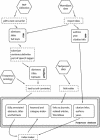Textpresso: an ontology-based information retrieval and extraction system for biological literature
- PMID: 15383839
- PMCID: PMC517822
- DOI: 10.1371/journal.pbio.0020309
Textpresso: an ontology-based information retrieval and extraction system for biological literature
Abstract
We have developed Textpresso, a new text-mining system for scientific literature whose capabilities go far beyond those of a simple keyword search engine. Textpresso's two major elements are a collection of the full text of scientific articles split into individual sentences, and the implementation of categories of terms for which a database of articles and individual sentences can be searched. The categories are classes of biological concepts (e.g., gene, allele, cell or cell group, phenotype, etc.) and classes that relate two objects (e.g., association, regulation, etc.) or describe one (e.g., biological process, etc.). Together they form a catalog of types of objects and concepts called an ontology. After this ontology is populated with terms, the whole corpus of articles and abstracts is marked up to identify terms of these categories. The current ontology comprises 33 categories of terms. A search engine enables the user to search for one or a combination of these tags and/or keywords within a sentence or document, and as the ontology allows word meaning to be queried, it is possible to formulate semantic queries. Full text access increases recall of biological data types from 45% to 95%. Extraction of particular biological facts, such as gene-gene interactions, can be accelerated significantly by ontologies, with Textpresso automatically performing nearly as well as expert curators to identify sentences; in searches for two uniquely named genes and an interaction term, the ontology confers a 3-fold increase of search efficiency. Textpresso currently focuses on Caenorhabditis elegans literature, with 3,800 full text articles and 16,000 abstracts. The lexicon of the ontology contains 14,500 entries, each of which includes all versions of a specific word or phrase, and it includes all categories of the Gene Ontology database. Textpresso is a useful curation tool, as well as search engine for researchers, and can readily be extended to other organism-specific corpora of text. Textpresso can be accessed at http://www.textpresso.org or via WormBase at http://www.wormbase.org.
Conflict of interest statement
The authors have declared that no conflicts of interest exist.
Figures




References
-
- Alper S, Kenyon C. The zinc finger protein REF-2 functions with the Hox genes to inhibit cell fusion in the ventral epidermis of C. elegans . Development. 2002;129:3335–3348. - PubMed
-
- Andrade MA, Bork P. Automated extraction of information in molecular biology. FEBS Lett. 2000;476:12–17. - PubMed
-
- Bei Y, Hogan J, Berkowitz LA, Soto M, Rocheleau CE, et al. SRC-1 and Wnt signaling act together to specify endoderm and to control cleavage orientation in early C. elegans embryos. Dev Cell. 2002;3:113–125. - PubMed
-
- Blaschke C, Valencia A. Molecular biology nomenclature thwarts information-extraction progress. IEEE Intell Syst. 2002;17:73–76.
Publication types
MeSH terms
Substances
Grants and funding
LinkOut - more resources
Full Text Sources
Other Literature Sources
Molecular Biology Databases

